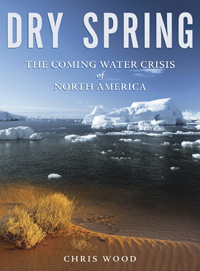
[Editor's note: This is the second of two excerpts from Chris Wood’s new book Dry Spring: The Coming Water Crisis of North America.]
We Canadians are damn serious about “our” water.
It’s a source of pride for a national ego otherwise notoriously wracked by doubt. You could fit our population into greater Tokyo with futons to spare, our economy barely makes it over the threshold into the G-8 and our undersea navy may famously be outnumbered by the toy submarines at the West Edmonton Mall.
But when it comes to water, Canada is the 800-pound gorilla on the block. Few suggestions raise our temperature faster than that we should sell any of it, especially to America.
And few beliefs are more deeply lodged in our collective subconscious than that one day Uncle Sam will insist that we do just that. That makes it a touchy topic. After one American expert spoke in favour of continental trade in water to an audience in Vancouver, he said afterward, only partly in jest, “I felt some need to leave the country very quickly.”
Left-leaning water activists work tirelessly to inflame Canadians against this “looming threat” from next door.
Thirsting for our water
“Canada is under pressure to sell water to the United States by pipeline or diversion,” insists the Council of Canadians on its website.
The drumbeat that the Americans are coming for Canada’s water crosses most of Canada’s political divides. Peter Lougheed, the famously level-headed former premier of Alberta who helped to negotiate free trade with the United States, also believes that, “at some stage of the game, Washington is going to interpret the Free Trade Agreement and think they have a claim over our fresh water. It’s coming.”
When it does, “Canadians should be prepared to respond firmly with a forceful, ‘No, we need it for ourselves.’ ”
Even the generally pro-American and pro-market Alberta pundits Barry Cooper and David Bercuson have characterized any future dealings with the United States over water in terms of a mugging.
Water to share
Let’s give ourselves a shake here: there is virtually no likelihood that the U.S. will suddenly decide to twist our tap and drain us dry.
And despite that general truth, should a few local opportunities arise here and there to sell modest quantities of water to Americans, doing so wouldn’t trigger the kind of continental demand for every drop of our water that activists invoke.
Our water has in fact flowed south by truck and pipeline for years, and yet no stampede of NAFTA-quoting claimants has appeared at the border demanding to stick a pipe in Lake Athabasca.
There’s more. If Americans or others do arrive at Canada’s door with checkbooks and empty billycans, we shouldn’t send them away.
Not because they might be armed and desperate. But because the water that used to fall on other lands now falls on ours; because we can spare a little in ways that won’t harm our environment (and that certainly make more ecological sense than pumping it into the ground to push out oil); and yes, because we can make money by doing so.
For proof that a little buying and selling of water over the border won’t bring down the sky, you need to get out of committee-rooms and let the Alberta wind ruffle your hair.
Sale or no sale?
For more than 40 years, beneath the sagebrush that surrounds the hamlet of Coutts, Alberta, a pipeline has carried water withdrawn from the Alberta reach of the Milk River south to the Americans of Sweetgrass, Montana.
In a typical month, 3,600 cubic metres flow down the pipe and over the border. In exchange, Sweetgrass’ only governing body, its Sewer and Water Board, pays Coutts roughly $4,000. Whether this constitutes a sale is a matter of interpretation.
“We buy our water from Coutts,” asserts Helen van Ruden, a frank, businesslike woman in chinos and jean shirt who works at the UPS forwarding warehouse on the U.S. side. “We have for as long as I’ve lived here. We pay per gallon. It’s been great.”
Coutts Mayor Jamie Woodcock is a large fellow who staffs a much smaller UPS outpost on the Canadian side. He agrees that the arrangement works well. When Coutts had to upgrade its water treatment recently, Sweetgrass shared the cost through a hike in its water rate. But, he insists, “We don’t sell it to them. We charge a fee for delivering and chlorination. We’re not actually selling the water.”
What the original contract may say on the point is unknown. It’s been lost for years.
Water security: a joint project
Water carries no passport. It is never exclusively “ours” or “theirs.” Like carbon and air, it’s always passing through on its way to somewhere else. For that unavoidable reason, Canadians delude ourselves in imagining that we can achieve our own water security in splendid isolation from our neighbours.
Again, the fear is not that going it alone would invite a stand-and-deliver ultimatum from a thirsty America (it wouldn’t). It is simply that we will best protect the water that gives life to us both, by acting together. The price of failure to do so is written in the loose sand and blackened marshes of the former Colorado Delta.
Water is a physical fact. Its challenges are always specific to the ground it flows over. Adversaries over water are usually neighbours; solutions require local compromise.
The boundaries of the conflict are typically those of the watershed, the area within which all water passes to a common outlet. Within these natural frontiers described by elevation and physics, and heedless of our invisible lines, the river course connects a single, seamless biological habitat strung out along a chain of pools from burbling beginnings to its easeful slide into the sea.
Nature's geography
Here, every human appropriation affects every other user (human and otherwise) not only downstream but often upstream as well. If we wish to adapt to the coming storms at the least financial and ecological cost, while giving ourselves the best chance to avoid conflict, we must start here: by allowing nature’s geography to trump our imaginary one in shaping not only our physical infrastructure, but our social and political infrastructures too.
Policy professionals call this idea “integrated watershed (or river basin) management.”
Kindy Gosal is a policy pro with more dirty-fingernail experience than most. Raised from the age of six in the Kootenay Mountains of southeastern British Columbia, he became a forester, he says, “to get away from people.”
He discovered instead that most of what threatened the health of trees came not from the forest itself but from humans. Taking this knowledge abroad, he helped communities in Africa, Tibet and Japan manage crop and forest lands more sustainably -- and realized that water was the thread connecting every activity that bore on social as well as forest health in those places.
Now Gosal works with the Columbia Basin Trust, an organization funded indirectly by proceeds from the hydroelectric developments in that river basin and meant to give a stronger voice to its inhabitants.
Gosal accepts that integrated watershed management has a wonky name. But he believes deeply in its intent: to ensure that the choices we make as individuals and societies account fully for their consequences for everyone and everything else.
Bureaucratic tangle
In the real world, that inclusive aspiration is quickly lost in the thicket of interests involved. In just the Canadian portion of the Columbia River Valley, Gosal tells me, no fewer than 19 federal and 17 provincial agencies have duties that affect water, not including municipalities, First Nations and private landowners.
“You have [communities with] responsibility to provide potable water,” he observes, “but they can’t prevent someone from putting in a pig farm.”
What he calls “the essence” of integrated watershed management “is getting all the folks together who have some influence over watercourses, and the people that use the watercourse, so that you recognize what kind of activities are required to maintain the quantity and quality [of water] that we want.”
The potential for conflict among fragmented authorities plagues politically divided river basins within and between nations around the world. So it is both striking and encouraging to find that in the last two decades a common desire on both sides (or ends) of these shared streams has engendered a remarkable phenomenon: new entities concerned with entire watersheds have appeared on every continent.
Even here in North America, the compelling case for managing migratory water on a watershed basis has begun to overcome American touchiness about relinquishing sovereignty to foreign agents and Canadians’ reciprocal distrust of U.S. motives.
From the Rockies to the Atlantic, citizens of both nations are working to give structure and capacity to a new breed of institution that must work within, but also across, legal frontiers.
Time to act
Yet the clock is ticking. The change in the weather -- increasingly unexpected, violent, alternately drenching and desiccating -- is accelerating around us. Overhead, greenhouse gases will reach the trigger point for an unpredictable escalation of climate change in less than a decade. Any response, physical or institutional, will take at least that long to realize. Sooner rather than later, act we must.
If we are attentive, it may take but one or two devastating droughts and floods bearing Biblical comparison to persuade us that our old plumbing and practices are insufficient to the new extremes of “normal” weather.
Cringe as we may from adding more dams and pipelines to our already over-engineered continent, we’ll still need to find new places to store a little of the flood to drink (and grow and make things with) during the drought that is certain to follow. In the event we may favour a few dams or pipes after all.
Solutions
But if we’re honest about it, we’ll find ways that are smarter, easier, kinder to the planet and, in the long run, cheaper to ourselves.
Using landscaping rather than dikes to temper extremes of rainfall.
Distributing our next big reservoir virtually among a thousand home cisterns or stashing it invisibly underground.
Piping industrial zones for the commercial exchange of waste-water.
Protecting rivers by preserving (and re-establishing) wetlands that filter their living water.
Even letting our beloved lawns go brown through August.
Solutions to our avoidable water “crisis” are at every hand, within reach of each of us.
They are ready to be unleashed by one critical concession: a more candid accounting of nature’s services to our market economy. Our most successful strategy will integrate our human industrial economy back into nature’s biological one wherever possible, adopting and sharing the planet’s own design for responsive, long-term resilience.
Plainly we can do that most effectively if we respect nature’s arena of action, the watershed. We must put differences across arbitrary borders into perspective against the larger stakes that we have in common.
The biggest reason Canada’s aqua-nationalists are wrong in their isolationism is finally this: we
can only do what we need for ourselves by working, and acting, together with the
neighbours. ![]()





